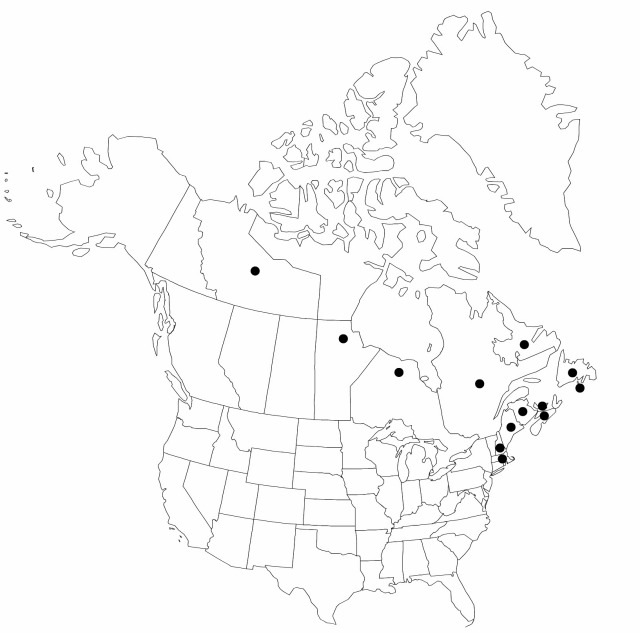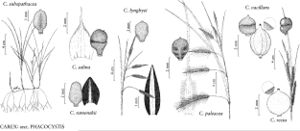Carex paleacea
Kongl. Vetensk. Acad. Nya Handl. 24: 165. 1803.
Plants not cespitose. Culms obtusely or acutely angled, 15–80 cm, glabrous or minutely scabrous. Leaves: basal sheaths brown or redbrown; sheaths of proximal leaves glabrous, fronts lacking spots and veins, apex U-shaped; blades hypostomic, 4–8 mm wide, abaxially papillose. Proximal bract equal to or longer than inflorescence, 3–8 mm wide. Spikes usually pendent; staminate (1–) 2–3; pistillate 2–7; proximal pistillate spike 2.2–6.5 cm × 5–13 mm, base obtuse. Pistillate scales yellowbrown; 3.4–20 × 1–1.7 mm (including awn), midvein reaching apex, 1/3–1/2 the width of scale, apex acuminate or retuse, aristate, awn scabrous. Perigynia divergent, pale-brown, 0–50-veined on each face, thick-walled, somewhat inflated, loosely enclosing achenes, ellipsoid, 2.4–4 × 1.3–1.9 mm, leathery, dull, base with stipe to 0.5 mm, apex acute, short-papillose; beak cylindric, 0.2–0.4 mm, entire. Achenes deeply constricted on 1 margins or 1 face, apex rounded, glossy; style base strongly bent. 2n = 71, 72, 73.
Phenology: Fruiting Jul–Sep.
Habitat: Saline, brackish, and intertidal marshes, shores, river estuaries
Elevation: 0–10 m
Distribution

St. Pierre and Miquelon, Man., N.B., Nfld. and Labr., N.S., Ont., P.E.I., Que., Maine, Mass., N.H., Eurasia
Discussion
Smaller and depauperate plants of Carex paleacea, mostly from rocky habitats, and aberrant individuals were considered to be hybrids by E. Lepage (1956, 1957, 1957b, 1967, 1976b) even if they were fertile. The following are included in Carex paleacea: C. ×neopaleacea E. Lepage (= C. paleacea × C. buxbaumii), C. ×paleacoides E. Lepage (= C. paleacea × C. glareosa var. amphigena), and C. ×gauthieri E. Lepage (= C. paleacea × C. recta). Similar depauperate plants have been cultivated in an experimental garden and were found to be identical to typical C. paleacea. Their unusual appearance was interpreted as the result of environmental phenotypic modifications (J. Cayouette and P. Moriset 1985, 1986b). Type specimens of both C. ×gardneri E. Lepage and C. ×sublimosa E. Lepage are C. paleacea, but the hybrids C. paleacea × C. salina and C. limosa × C. paleacea do exist. Other verified and accepted hybrids of C. paleacea include C. ×neofilipendula E. Lepage (C. aquatilis), C. ×exsalina E. Lepage (= C. paleacea × C. bigelowii), C. ×saxenii M. Raymond (= C. paleacea × C. recta). Carex nigra × C. paleacea (= C. ×subnigra E. Lepage) is C. vacillans, and C. paleacea × C. stylosa var. nigritella (= C. ×ungavensis E. Lepage) is probably a hybrid involving C. paleacea.
Selected References
None.
Lower Taxa
"shortened" is not a number.
